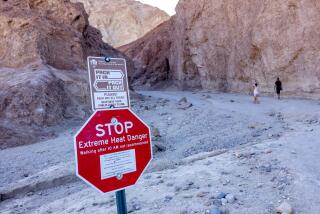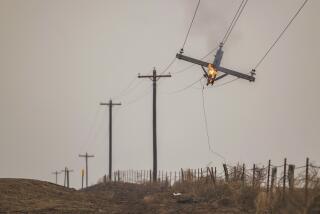Weather extremes may be the new norm
- Share via
LOS ANGELES AND MARSHALL, OKLA. — Oklahomans are accustomed to cruel climate. Frigid winters and searing summers are often made more unbearable by scouring winds. But even by Oklahoma standards, it’s been a year of whipsaw weather.
February was so cold -- with the wind chill it felt like 16 below -- that Tim Gillard installed a door in the long hallway of his home in the small farming town of Marshall, walling off three rooms to more affordably heat the rest of the house. Now, in this summer’s unrelenting heat, his family huddles in the air conditioning behind that same door.
The Gillards’ respite ended this month when a windstorm knocked out the town’s electricity. That sent many of Marshall’s 290 beleaguered residents out to their porches at night to sleep, cooler than inside but still sweltering. In July, Oklahoma’s average statewide temperature of 89 was the highest ever recorded for any state.
Oklahoma’s misery has been writ large across the country this year, which federal climate scientists have labeled one of the worst in American history for extreme weather. With punishing blizzards, epic flooding, devastating drought and a heat wave that has broiled a huge swath of the country, the 2011 weather has been unrelenting and extraordinary.
In addition to hundreds of deaths from cold and heat and tornadoes, the national economic toll for extreme weather so far this year is estimated at $35 billion, more than five times the average annual loss.
And, climatologists warn, get used to it.
The year has been so wild that Gary McManus has given up keeping track of the weather records set in Oklahoma. Begrudgingly, McManus, the associate state climatologist, briskly rattled off a few:
* The all-time low temperature (31 degrees below zero).
* Greatest 24-hour snowfall total (27 inches).
* Most tornadoes in one month (50 in April).
There’s been no measurable rain in the western half of the state since October. The 11-month period ending in August was the driest such period statewide since records were first kept in 1895.
McManus said this year’s back-to-back weather calamities were “out of the realm of your imagining. It’s not just that temperatures are above normal, it’s that it’s above normal for so many months in a row.” And this is the state that bore the brunt of the Dust Bowl.
“It’s Oklahoma, it’s feast or famine,” said Annette Gonzales, 58, acting Marshall postmaster. “It’s always extreme.”
Oklahoma’s heat wave has so far claimed 14 lives. Since 2000, Oklahoma has had more federally declared weather-related disasters than any other state.
The weather’s apparent caprice puzzled many as it played across the continent: Farmers in Texas and Oklahoma unable to plant during the worst drought on record watched as farmers along the Mississippi River lost their fields to floodwater. Much of the nation suffered through stifling heat while the West Coast enjoyed a notably mild summer.
Climate scientists point to the predictable and cumulative effects of climate change -- both hot and cold -- to account for much of the extreme weather, although the connection between tornadoes and climate is not clear. In any event, scientists caution that the future will hold greater temperature extremes, and for longer duration.
Officials at the National Oceanic and Atmospheric Administration say that extreme weather events have been more frequent since 1980.
“I think it would be a mistake to not think that this has become the new normal,” McManus said. “Until it stops happening, we should expect it to continue.”
The winter brought ice storms and snow from Mexico to Canada. The “Groundhog Day blizzard,” which began in late January, brought Chicago to a standstill, dumped 21 inches of snow at O’Hare International Airport and killed 36 people.
But the spring and summer have packed a wallop of willful and dangerous weather. April spawned 875 tornado reports -- the 30-year average for the month is 135. The “super outbreak,” as climatologists dubbed it, killed 327 people.
Floodwaters sprang from the Red River to the Ohio River. A string of enormous storms saturated the Ohio Valley, where precipitation was more than 200% above normal.
The Mississippi River crested from Illinois to Louisiana. As the Mississippi continued to rise, threatening major cities along its banks, a district judge ordered the Army Corps of Engineers to open the Morganza Spillway, inundating 4,600 square miles of Louisiana bottom land along with rural farmsteads and fields.
At times one weather crisis begot another. The storm cells parked above the Ohio Valley blocked the much-needed moisture from the Gulf of Mexico from reaching the southern Plains, exacerbating the region’s drought.
Heat and aridity smothered Texas, where 2 million acres were consumed by wildfires in late spring. Another record.
Drought-caused agricultural losses in Texas have been tallied at $5.2 billion so far. Some of the state’s water-starved cities are beginning programs to recycle treated sewage for household use, a practice known as “toilet to tap.”
The Lone Star State has been so beset by weather emergencies that Gov. Rick Perry has made a state disaster declaration every month since December.
In many states, late summer has been awful by any measure. Back-to-school excitement turned deadly this month when three high school football players and a coach died during practices in a 10-day period in Texas, Georgia and South Carolina. A police dog in St. Martinville, La., died of heat stroke while chasing two suspects this month. Some states are reporting a rash of thefts of air-conditioning units.
“This summer is a good wake-up call not to take nature lightly,” said Katherine Hayhoe, an atmospheric scientist at Texas Tech University. “No matter people’s perspectives about climate change, this year has helped highlight our vulnerability. Climate change increases the risk of what happens naturally.”
Marshall’s woes are especially troubling, as the town in north-central Oklahoma is populated with the poor or elderly who can scarcely afford to prepare against the elements.
The Gillards -- 48-year-old Tim, 34-year-old Maygin and their four children -- moved to Marshall right before the big snowstorm in February. Maygin Gillard’s grandfather built the house more than 40 years ago, and it has no central heating or air conditioning. The walls have some insulation, but not much. During the winter, the family uses a wood-burning stove and electric heaters.
During one cold spell the family could not travel for two days because the town’s gas pumps froze.
“It’s been absolutely nuts,” Maygin Gillard said. “Somebody made Mother Nature mad this year.”
The summer’s heat wave has been tough on all of the Gillard children, but especially their youngest son, 11-year-old Masion, who has asthma and diabetes. The boy is forced to stay inside because the heat is so hard on him.
The blocked-off half of the house, Gillard said, feels like a sauna. If she has to get something from it, she peeks around the door to locate the item, runs to it, then races back to the cool area. The other day the heat caused a bottle of glue to explode.
Shirley Harrington, 52, lives in a double-wide trailer next to the Marshall post office. When the power went off this month, she dropped off her paralyzed husband, Mike, 56, and their dog at her mother-in-law’s house 39 miles away in Enid. He requires oxygen at night and has to use a nebulizer three times a day. Both require electricity.
Mike Harrington worked on oil rigs until he suffered a spinal cord injury after being hit in the head with a metal block.
Most of his body is numb, and, though he can walk unsteadily, he is largely confined to a wheelchair and can’t feel hot or cold, so Shirley has to watch him closely when severe weather hits.
With her husband safely in Enid, she slept one night on her outdoor swing, listening to the hum of her neighbors’ generators.
When power was restored two days later, she brought Mike home -- and bought a generator.
Last week she cut down a 20-year-old mimosa tree in her yard. She had planted it after her father died. The heat finally killed it.
“I called it Daddy’s Tree. It broke my heart having to take it down, but I said, ‘Daddy, I’ll get you a new tree, somehow, some way,’ ” she said.
--
Branson-Potts is a special correspondent.
More to Read
Sign up for Essential California
The most important California stories and recommendations in your inbox every morning.
You may occasionally receive promotional content from the Los Angeles Times.











